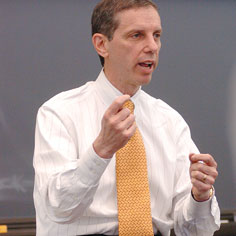
Steve Joachim Provides Leadership for Securities Industry
Most of us follow the stock and other securities markets through newspapers and Web sites and with the help of brokers. Steve Joachim has experienced the dynamics of these markets from the inside.
Throughout his career, Joachim has witnessed technology transform the financial sector. Computational modeling grew to be a critical part of the securities industry. Dealers and investors switched from telephones to computers and the Internet for communication and information-sharing. And available information about securities expanded exponentially. Joachim used his unique training to help his companies weather the financial market falls of 1987 and 2000. Then, just several years later, he launched a database that is now dramatically changing the securities industry.
And it all started with his undergraduate work at Carnegie Mellon, the beginning of an education that he describes as the foundation of his current success at the National Association of Securities Dealers (NASD) and in other posts he has held along the way.
A Unique Education
Joachim earned his undergraduate degree in mathematical sciences (S'71) and a master's degree in public management (HNZ'75) from Carnegie Mellon and a master's degree in political science from Duquesne University. He has spent more than 20 years in finance, first with Bankers Trust and then with Merrill Lynch. At Merrill Lynch he served as business manager equity trading and director of floor broker services, first vice president, business architect for capital markets, and chief technology officer for equity markets.
He went on to become the Chief Operating Officer and Chief Strategy Officer of Plural, a custom interactive software development and strategy firm. He guided the firm during the dot-com boom, when Plural experienced a more than fourfold expansion until 2000. Then the dot-com bubble burst. The company shrank back to near to its original size by 2002.
Preventing Financial Disasters
Not long after this experience, a recruiter asked Joachim if he would be interested in joining NASD, the private sector selfregulatory arm of the securities industry whose mission is to bring integrity to the markets and to protect investors. NASD members include all broker dealers doing business with the United States public-about 5,200 firms, more than 104,000 branch offices and more than 660,000 registered securities representatives. Joachim saw the position as an opportunity to use his skills and experience to serve the public interest and to prevent disasters like the dot-com speculative bubble.
"I joined because I thought that regulation was going to be critical to the industry in the aftermath of the late '90s," Joachim said, "and because my specific role offered an opportunity to play a major part in revolutionizing the way bonds are traded."
Of his industry, Joachim added, "There's no question that we're starting a new stage of evolution. And we're more interested than ever before in building stronger financial, analytical, problem solving and technology skills that will allow us to get ahead of the curve, so that we can anticipate rather than simply react to change in the marketplace."
As executive vice president of transparency services for NASD, Joachim directed the launch of TRACE, a real time database of market transaction reports. Prior to TRACE, each dealer set its prices independently. Investors could not see comparable prices and had no way of judging if they received a fair price. TRACE provides investors with reliable and up-to-date information so they can check comparable prices and ensure that they are getting competitive rates. Joachim and others in his field describe TRACE as a major victory for investors.
Looking Ahead
Getting reliable information to the public is a large part of regulating the securities industry, one that is both enabled and challenged by the latest technology. Prior to the 1990s and the Internet, investors needed to go to a broker or dealer for information. Now, information is everywhere. The securities industry, however, still faces the problem of how to make sure that people receive reliable, consistent and accurate information on which to base their investment decisions. Joachim points to this problem as a major new focus in the field of securities regulation. The volume and speed of transactions also are increasing as technology becomes more advanced and information becomes more accessible.
"In the 1960s, the New York Stock Exchange had to close on Wednesdays because they couldn't handle the flow of paper," said Joachim. "In 1968, they were doing 6 million shares a day. Now we're doing 6 million shares in the first second of the market. We trade 1.5 billion shares a day."
With technology and the securities marketplace constantly changing and growing, regulatory groups like the NASD require a new brand of professional able to anticipate market changes, leverage technology and stay one step ahead.
"The set of skills you need to be a successful regulator today are analytics, technology, business skills, all the basic core skills that Carnegie Mellon draws people toward," said Joachim, who values mathematics as the root of these core skills. "Mathematics provides a terrific foundation. It is the basis for all the sciences, engineering, technology and the business world. I think it gives you the flexibility to do almost anything."